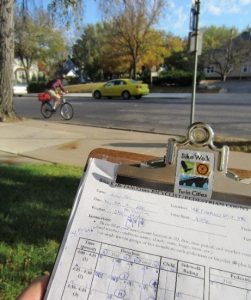 Gathering information about the built environment and the behaviors of people walking, rolling and driving can serve several purposes. The results can be used to understand what’s helping support active travel and what safety problems and other barriers exist. They can also be used to quantify and describe road user experiences to present to decision makers when requesting help in making safety improvements. Finally, they can serve as opportunities to bring professionals, advocates, community members and decision makers together to identify problems and discuss solutions. The needs of all active travelers should be considered, so including people with disabilities in the planning and conduct of the assessment and including considerations for people with disabilities in the audits themselves are critical. Consider the following resources and which might best support your efforts.
Gathering information about the built environment and the behaviors of people walking, rolling and driving can serve several purposes. The results can be used to understand what’s helping support active travel and what safety problems and other barriers exist. They can also be used to quantify and describe road user experiences to present to decision makers when requesting help in making safety improvements. Finally, they can serve as opportunities to bring professionals, advocates, community members and decision makers together to identify problems and discuss solutions. The needs of all active travelers should be considered, so including people with disabilities in the planning and conduct of the assessment and including considerations for people with disabilities in the audits themselves are critical. Consider the following resources and which might best support your efforts.
Active Routes to School Accessibility Survey by the North Carolina Office on Disability and Health
With a focus on the needs of people with mobility disabilities using an active route to school, this resource includes a list of people to invite, a checklist and form for additional comments.
Walk Audit Toolkit by AARP
While not specific to school travel, this toolkit offers options for single-location or route assessments, a vocabulary list, worksheets for sidewalks, streets, crossings, and more. It also includes ideas for how to take action on the results. Available in English and Spanish.
Inclusive Walk Audit Facilitator’s Guide by Minnesota Department of Health, Alta Planning + Design and This Inclusive Life
The guide includes recommendations to plan a more inclusive meeting and to conduct a more inclusive walk audit. The guide also discusses suggestions to create a virtual walk audit.